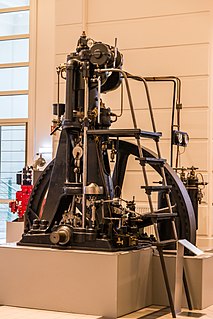
The diesel engine, named after Rudolf Diesel, is an internal combustion engine in which ignition of the fuel is caused by the elevated temperature of the air in the cylinder due to mechanical compression; thus, the diesel engine is a so-called compression-ignition engine. This contrasts with engines using spark plug-ignition of the air-fuel mixture, such as a petrol engine or a gas engine.

Carl Friedrich Benz, sometimes also Karl Friedrich Benz, was a German engine designer and automotive engineer. His Benz Patent Motorcar from 1885 is considered the first practical automobile and first car put into series production. He received a patent for the motorcar in 1886.

Fuel injection is the introduction of fuel in an internal combustion engine, most commonly automotive engines, by the means of an injector. This article focuses on fuel injection in reciprocating piston and Wankel rotary engines.

Wilhelm Maybach was an early German engine designer and industrialist. During the 1890s he was hailed in France, then the world centre for car production, as the "King of Designers".
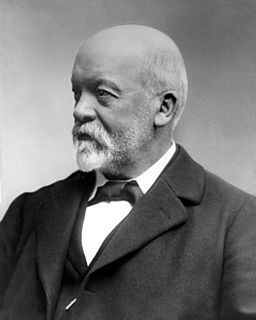
Gottlieb Wilhelm Daimler was a German engineer, industrial designer and industrialist born in Schorndorf, in what is now Germany. He was a pioneer of internal-combustion engines and automobile development. He invented the high-speed liquid petroleum-fueled engine.

Ferdinand Anton Ernst Porsche, mainly known as Ferry Porsche, was an Austrian-German technical automobile designer and automaker-entrepreneur. He operated Porsche AG in Stuttgart, Germany. His father, Ferdinand Porsche, Sr. was also a renowned automobile engineer and founder of Volkswagen and Porsche. His nephew, Ferdinand Piëch, was the longtime chairman of Volkswagen Group, and his son, Ferdinand Alexander Porsche, was involved in the design of the 911.

The Mercedes-Benz C-Class is a series of compact executive cars produced by Daimler AG. Introduced in 1993 as a replacement for the 190 (W201) range, the C-Class was the smallest model in the marque's line-up until the W168 A-Class arrived in 1997. The C-Class has been available with a "4MATIC" four-wheel drive option since 2002. The third generation (W204) was launched in 2007 while the current W205 generation launched in 2014.

Gutbrod was a German manufacturer of cars, motorcycles and small agricultural machinery. The firm was founded in Ludwigsburg, Germany by Wilhelm Gutbrod in 1926. It originally built "Standard" branded motorcycles. In 1933 the company relocated to the nearby Stuttgart suburb of Feuerbach, and from 1933 to 1935, Standard Superior cars were built with rear-mounted engines.
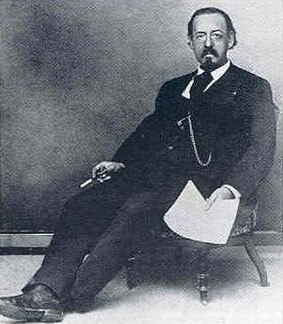
Siegfried Samuel Marcus was a German inventor. Marcus was born of Jewish descent in Malchin, in the Grand Duchy of Mecklenburg-Schwerin. He made the first petrol-powered vehicle in 1864, while living in Vienna, Austria.
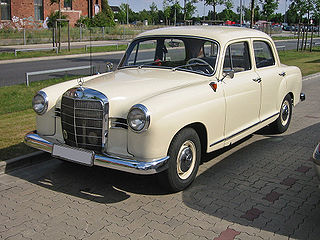
The Mercedes-Benz W 120 and Mercedes-Benz W 121 are technically similar inline-four cylinder sedans made by Daimler-Benz. The W 120 was first introduced by Mercedes-Benz in 1953. Powered initially by the company's existing 1.8 liter M 136 engine, it was sold as the Mercedes-Benz 180 through 1962. From 1954, Mercedes-Benz also offered the W 120 with a diesel engine as the Mercedes-Benz 180 D. The Mercedes-Benz W 121 was introduced as the Mercedes-Benz 190 in 1956, powered by a 1.9 liter M 121 engine. From 1958, the W 121 was also offered with an OM 621 engine, sold as the Mercedes-Benz 190 D through 1961.

Daimler-Motoren-Gesellschaft was a German engineering company and later automobile manufacturer, in operation from 1890 until 1926. Founded by Gottlieb Daimler and Wilhelm Maybach, it was based first in Cannstatt. Daimler died in 1900, and their business moved in 1903 to Stuttgart-Untertürkheim after the original factory was destroyed by fire, and again to Berlin in 1922. Other factories were located in Marienfelde and Sindelfingen.
Dr. Ernst Fuhrmann was chairman of Porsche AG between 1972 and 1980. He was a German citizen.
Mercedes-Benz, commonly referred to as Mercedes, is a German luxury automotive brand. Both Mercedes-Benz and Mercedes-Benz AG are headquartered in Stuttgart, Baden-Württemberg, Germany. Mercedes-Benz produces consumer luxury vehicles and commercial vehicles. Its first Mercedes-Benz-badged vehicles were produced in 1926. In 2018, Mercedes-Benz was the largest seller of premium vehicles in the world, having sold 2.31 million passenger cars.

Paul Daimler was a German mechanical engineer who designed automobiles. He was the eldest child of Gottlieb Daimler who founded Daimler-Motoren-Gesellschaft and invented the petrol engine.
Fritz Nallinger was a German automobile engineer and executive.

The Mercedes-Benz W02 was a midsize six-cylinder two-litre-engined automobile introduced by Daimler-Benz at the Berlin Motor Show in October 1926. It was developed in some haste under the manufacturer's Technical Director, Ferdinand Porsche in parallel with the smaller Mercedes-Benz W 01 and the larger three-litre-engined Mercedes-Benz W03 following the creation of Daimler-Benz, formally in July 1926, from the fusion of the Daimler and Benz & Cie auto-businesses.

The Gutbrod Superior is a small car, built from 1950 until 1954 by German manufacturer Gutbrod. A total of 6,860 cabriolet saloons and 866 estates were built in less than four years.
Josef Herbert Ernst Fiala is an Austrian automotive engineer.
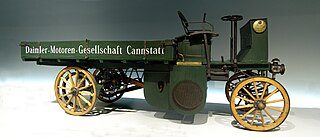
The Daimler Motor-Lastwagen is the world's first truck, manufactured in the year 1896 by Daimler Motoren Gesellschaft and designed by Gottlieb Daimler.
Hans Nibel was a German mechanical engineer.














